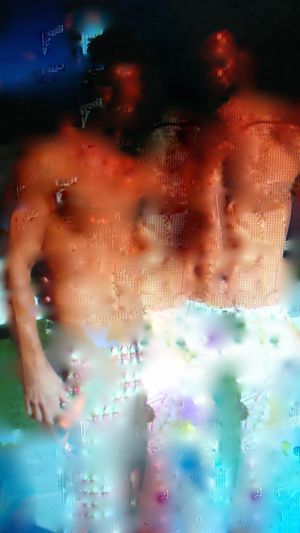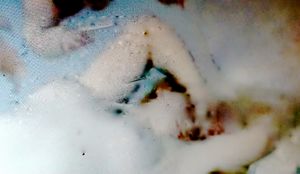Artyom proposal draft: Difference between revisions
No edit summary |
No edit summary |
||
| Line 7: | Line 7: | ||
[[File:Artyom-pp-1.jpeg|thumbnail|center]] [[File:Artyom-pp-2.jpeg|thumbnail|right]] | [[File:Artyom-pp-1.jpeg|thumbnail|center]] [[File:Artyom-pp-2.jpeg|thumbnail|center|right]] | ||
Revision as of 16:51, 12 November 2014
Artyom - project proposal-draft
My graduation project is evolving around developing my visual language as an image-maker. In my practice I work mostly with photography and recently I started working with re-photography and digital manipulation techniques. In this latest experiments I’m interested in the characteristics of different mediums that are used to make and view images and how they affect the image. For example what is the difference between re-photography done from a computer screen or from a printed photography or from a beamed projection? As well as how the meaning of an image can change when being transformed from a medium to another, such as an image that has been re-photographed from a computer screen and then printed on paper. In this process I limit myself to the scope of ‘amateur’ - that is, working with limited tool that are considered as non-professional such as doing re-photography with a mobile phone and manipulating them in IPhoto. Within these lines of image-making and technology I see my work for the graduation show. Here some of my latest ‘sketches’.
The field of my interest is visual culture, more specifically image culture - the two dimensional world of images. Although this world is constituted by verity of mediums (numbers of which are growing with the development of technology) painting and photography can be taken as two main mediums of this culture. Our current image culture is no doubt formed around the photographic image which despise its problematic notions still has a reputation of being ‘true’ and ‘objective’ medium at least in wide spectrums of society.
The articulation on photography’s problematic notions already starts from Benjamin’s “Work of Art” where he talks about how the world is experienced differently through the camera than through human eye, thus it depict the world differently than perceived by humans. Benjamin compares the revolution of photography to one made by psychoanalysis.
“The camera introduces us to unconscious optics as does psychoanalysis to unconscious impulses.”
Since Benjamin there have been number of studies that deepened the understanding on this notion, such us Media Theories where the ‘false objectivity' of photography has been a recurring subject. The conclusion that can be drawn from these studies is that photography is not simply depicts reality but rather is as medium that produces a high degree of naturalistic illusion.
Taking this into account, we appear to be in culture where images claims to depict reality but nevertheless do not. This opens up several problematic questions, at least in regards to that we use photography as the main medium to ‘document’ and preserve our history.
Within this problematic context I the see the works and the position of the contemporary painters such us Marlene Dumas, Gerhard Richter, Peter Goig an so on. Working from existing images as a sours (mostly from photography) these painters already operate within the two-dimensionality of image rather than in three dimensionality of reality. Consequently their work is concerned with the reality that is depicted in the images rather than our reality. Although these artists operate in different areas of image culture, from iconic - media images to generic amateur photography, there are some crossways that their works meet. Richter’s “September” and Dumas’ two paintings of Bin Laden, “Osama” and “The Pilgrim”, are such example. This particular case, where the original is a photograph image that made history - a ‘giant’ in image culture, can be a good example to show these painter’s position within image culture.
In both of these works there is confrontation between two semiotics of painting and photography. These image-makers use the representational licence of painting to question the faculties of photography. In this process the paint does not simply representing the subject but it questions the subject - it comes to play the role of the ‘other’. Furthermore the image not simply takes its meaning from the original (photography) but from the matter that constitutes it - in other words the meaning derives from the gesture rather than what is depicted. Where Richter takes an image that has been fetishised by photography and physically scrapes away its symbolism, leaving vaguely recognisable elements merge with abstraction, Dumas two portraits of Bin Laden, that have been painted from the same source and presented next to each other, show the alternative connotations that the original image could’ve have. In both cases these paintings attempt to explain those ‘giant’ images that come to define our culture. They question the ‘certainty’ of photography with the ‘ambiguity’ of paint and in this process they create new images with new meanings. I’m particularly interested in this process, namely how images are ‘built’ on other images but rather than having only a referential position towards the original they transform the original and create new meanings.
Around these ideas - transforming images through different mediums and creating new meanings in this process, I’m organising my practise and research. My main question at this point will be ‘how can photography comment on itself - be its own ‘other’?’ As well I have few questions regarding the notions of reference within the image culture, such as ‘how can an image that is ‘built’ on another go beyond the ‘reference’.
I see my graduation project as a visual installation build around the these ideas. It will consist of collection of images which will be shown using different mediums; print, beamed or on screen, depending on the type of image. The images should engage in dialog with one another, both by their content and by the way they are displayed in space. For example it can be a installation with 3 beamers each of them projecting images in slideshow mode on 3 walls of the room. Each seth of 3 images can have certain associations with one another and create a context in which each of them can be seen.
Content wise I think it will have mixture of my ‘own’ images and images that are ‘built’ on other images. At this point I’m struggling to say what would be the exact concept behind the work since my practice has shown me that only through making and re-making I’m able to conceptualise my work.
Past summer I did several try outs where I was using classical painting as starting point for photography. While this process is the opposite of what contemporary painters are doing and has different challenges, nevertheless it brought me to the problematic are of ‘reference’. This challenge seemed more problematic for me in photography exactly because of its ‘objective’ notion as a medium. In other words photography struggles to be the ‘other’ because it claims to be ‘the thing itself’ which increases its chance to be a reference and decreases the chance to have its own meanings.
In this particular work my starting point was the image of “Death of Marat” by David. Where my first try outs were more of a literal representation - ‘references’, the later images manage to take a step further from the original and have a meanings of its own. In this process of ‘building’ an image on another I was struggling to have a balance between being too referential and excluding the original image entirely. My approach to this problem was to make my reference less literal, in formal (visual) sense, as in the first try outs but to make the reference more associative. For example using contemporary clothing by styling it in a way that it vaguely recumbence the 18th century costume - the time period of this painting. Furthermore I tried to not refer exactly to this painting but to have a light that is ‘painterly’, at the end keeping only the ‘hanging hand’ from the original sours. In regards to the attributes such as the computer screen or the ‘backstage’ elements of computer wires and so on, I used them again as balancing tool between painting and photography. Namely by using technology as an association to ‘modern’ in order to keep the image in the ‘photographic world’, not allowing it to fall into the ‘world of painting’ where it will become a simple reference to a classical image.
In regards to the larger, theoretical context I’ll be looking into studies of images provided by Media Theories. I’m in particular interested in theories of Vilem Flusser who was media theorist of late 20th century. Flusser’s two books “Towards a Philosophy of Photography” (1984) and “Universe of technical Images”(1985) are concerned with images in our technological age. In them he analyses images as medium and looks into their peculiarities as communication tools. Where in his first book Flusser looks at the overall history of images, from cave paintings to photography (still analog at the time), in the second book he concentrates on ‘technical’ images which can be understood in todays terms as digitally produced images such as photography and so on. Where art theory is more concerned on the contextual and formalistic aspects of images, media theory by taking into account the technological aspect, talks about images in more primal level, namely their actual construction (formation). This phenomena started with C.Shannon’s “A Mathematical Theory of Communication” (1948) who proposed a unit to calculate information - ‘bit’, which made it possible to calculate everything around us as information. This new way of seeing the world also enabled to examine things in a different way, including images and art in general. Flusser is one among many that uses the terms such as ‘message’, ’noise’, ‘redundancy’, that have been proposed in Shannon’s theory, to talk about images. Where the ‘message’ is the information that is carried by the image, the ‘noise’ is its inherit quality that distorts the message and ‘redundancy’ as a solution against the ‘noise’, by repeating - reaffirming the message. Besides Flusser I’m interested in the theories of Umberto Eco - a semiotician who also uses the Shannon’s theory to articulate on images. In his book “Open Work” he talks about how the notion that everything can be calculated as information came to affect art. Eco speaks of ‘openness’ of visual art, which can be described as deliberately allowing ‘noise’ into the message. This, Eco claims, is done by the artists in order to step away from giving to an image specific meaning (which would be ‘redundant’) and ‘opening it up’ for multiple meanings and interpretations. In this light Eco views the work of abstract painters of the second half on 20th century. A ’successful’ image than becomes the one that has maximum amount of ‘noise’ but it’s still carries a ‘message’ - its ‘openness’ is at maximum but nevertheless in not a ‘white noise’ where there is no message left at all.
This line of theoretical research seems to me to support my current artistic practice. Looking into theories such as Shannon’s, which came to play a fundamental role in our current culture, should help me to understand the developments in image culture. Since my work as this point is going towards the ‘digital’ area of images, theories of Flusser and Eco seem to provide the link between image and technology that I’m interested in. I see my theoretical research and my practice going hand in hand with each other, developments of which I can address in my practice based thesis.


